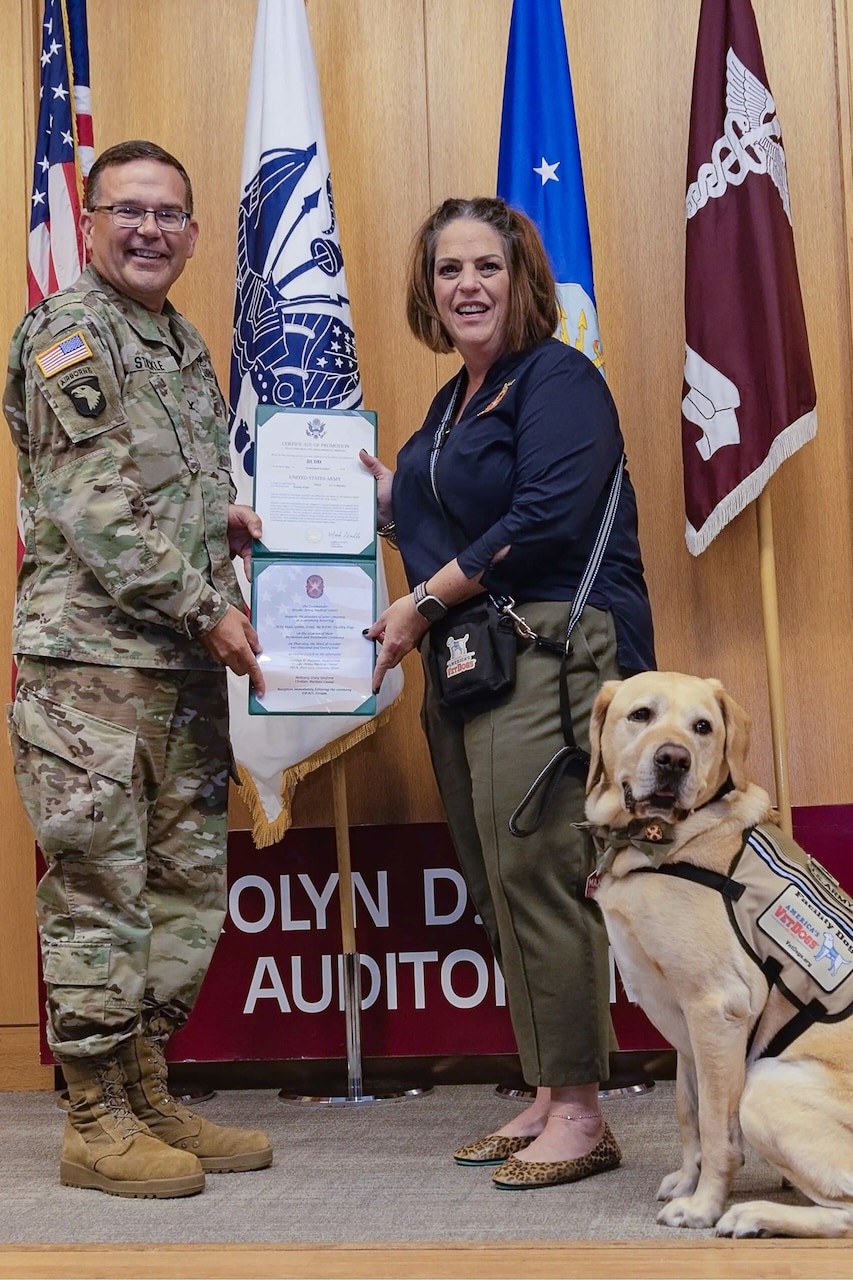 With a nose bop and paw salute, Brooke Army Medical Center promoted three of its five facility dogs during a special ceremony held on Oct. 3 in the Carolyn D. Putnam Auditorium.
With a nose bop and paw salute, Brooke Army Medical Center promoted three of its five facility dogs during a special ceremony held on Oct. 3 in the Carolyn D. Putnam Auditorium. During the ceremony, Budd, BAMC's first facility dog, was
 With a nose bop and paw salute, Brooke Army Medical Center promoted three of its five facility dogs during a special ceremony held on Oct. 3 in the Carolyn D. Putnam Auditorium.
With a nose bop and paw salute, Brooke Army Medical Center promoted three of its five facility dogs during a special ceremony held on Oct. 3 in the Carolyn D. Putnam Auditorium.  Marine Corps Staff Sgt. Lewis George Watkins served his country in the Navy during World War II, but when the Korean War began, he felt he still needed to do more. After rejoining the military as a Marine, he gave his life to save others during battle
Marine Corps Staff Sgt. Lewis George Watkins served his country in the Navy during World War II, but when the Korean War began, he felt he still needed to do more. After rejoining the military as a Marine, he gave his life to save others during battle
 A majority of service members in uniform can be identified by their last name thanks to the fabric, plastic or metal name tag that's generally attached over their right breast pocket. It's a small piece of the uniform, but it's the most important part
A majority of service members in uniform can be identified by their last name thanks to the fabric, plastic or metal name tag that's generally attached over their right breast pocket. It's a small piece of the uniform, but it's the most important part 
Military.com | By Konstantin Toropin[1]
Published
The Pentagon is rolling out a new pilot program that provides travel benefits to service members to cover the cost of flying people out to help with child care in the immediate days after arriving at a new duty station.
The new program aims to compensate service members for something that many of them have already been doing during a permanent change of station[2], or PCS[3] -- bringing friends or family members to help watch children while they settle in from the move and clear waiting lists.
"It's a significant step in supporting our military families -- reimbursing for these transportation costs," Christopher Woods, chief of the policy branch within the Defense Travel Management Office, told Military.com in an interview Wednesday. "It not only recognizes the unique challenges faced by the military, but also provides a tangible solution."
Read Next: 1,000 Active-Duty Soldiers Called Up to Assist with Hurricane Helene Response[4]
For a move within the continental U.S., reimbursement is capped at $500 and for a move to or from a duty station outside the continental U.S., the reimbursement is limited to $1,500.
"When I was a kid and I PCS'd with my dad, Grandma came out with us ... so these are things that people are currently doing now," Woods said. "This pilot is being put in place to offset those costs."
Woods said there are no major restrictions on who service members can designate for the stipend, except that they need to be older than 18 and not a dependent.
A defense official also noted that only one child-care provider is authorized per military family, even if both parents serve in the military.
The program was directed by Congress when they passed the 2023 National Defense Authorization Act, and it will run from now through Sept. 30, 2027.
Both Woods and Heidi Welch, the associate director for child and youth programs operations in the Office of the Secretary of Defense, said that the benefit is easily accessible through the MilitaryChildCare.com[5] website and the system will proactively ask them whether they want to take advantage.
"The system is going to say ... 'Are you going to need assistance with child care at your new duty station,'" before presenting a service member with the necessary paperwork, Welch said.
"This authorized child-care provider is treated very much the same way as the dependent would be treated, and so there's really nothing new that the service member has to learn or do differently," Woods noted.
Related: More Navy Child-Care Centers Are Coming to Drive Down Wait Times, But They're Struggling to Find Staff[6]
Military Headlines[7] Active Duty Benefits[8] Spouse and Family Benefits[9] Family and Spouse[10] Family Finances[11] Moving/Permanent Change of Station - PCS[12] PCS[13] Family Life[14] Military Kids[15] Department of Defense - DoD[16] Pentagon[17]
© Copyright 2024 Military.com. All rights reserved. This article may not be republished, rebroadcast, rewritten or otherwise distributed without written permission. To reprint or license this article or any content from Military.com, please submit your request here[18].